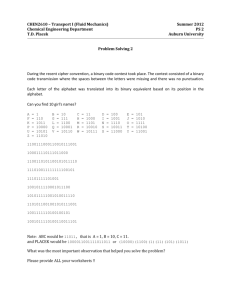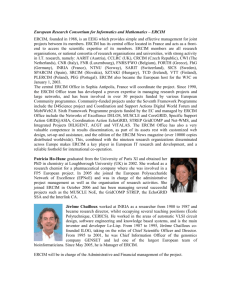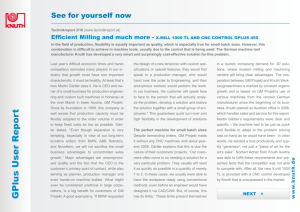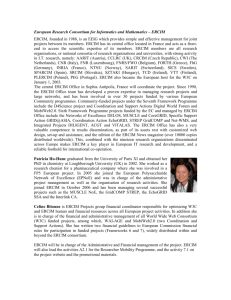EXONEST Exoplanetary Explorer - Kevin H. Knuth
advertisement
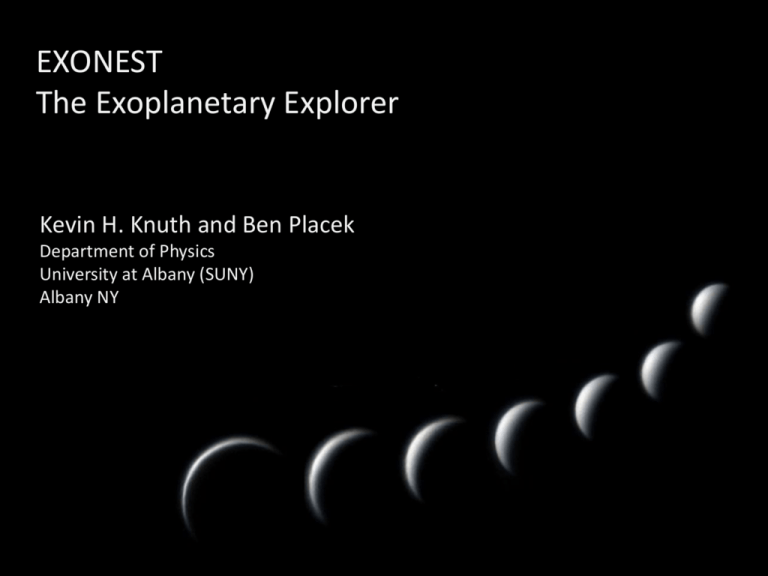
EXONEST The Exoplanetary Explorer Kevin H. Knuth and Ben Placek Department of Physics University at Albany (SUNY) Albany NY Kepler Mission Knuth and Placek ERCIM 2014 The Kepler mission, launched in 2009, aims to explore the structure and diversity of extra-solar planetary systems. Knuth and Placek ERCIM 2014 Knuth and Placek ERCIM 2014 Bayesian Inference Knuth and Placek ERCIM 2014 Bayes theorem acts as a learning rule that allows one to update their state of knowledge about the model parameter values given acquired data. Likelihood Prior 𝑃 𝜃 𝑀, 𝐼 𝑃 𝐷 𝜃, 𝑀, 𝐼 𝑃 𝜃 𝐷, 𝑀, 𝐼 = 𝑃 𝐷 𝑀, 𝐼 Posterior M θ D I Evidence (Z) = model = parameters = data = prior information EXONEST Exoplanetary Explorer Knuth and Placek ERCIM 2014 We have developed the EXONEST Exoplanetary Explorer which is a Bayesian Inference Engine equipped with plug-and-play models of exoplanetary photometric effects. The system will be made available to the public as open-source code so that third-party development of new photometric models of exoplanetary effects can be readily incorporated. EXONEST Exoplanetary Explorer Knuth and Placek ERCIM 2014 EXONEST Exoplanetary Explorer Data Bayesian Inference Engine Basic Stellar and Planetary Model Instrument Likelihood Plug-and-Play Orbital Models Transit Models Photometric Models Additional Models Parameter Estimates Model Evidence EXONEST [1] takes Data from the Kepler Space Telescope, CoRoT, etc. and given a specified model, produces model-based parameter estimates as well as the Bayesian evidence for that model [1] Placek, Knuth, Angerhausen, 2014 arxiv:1310.6764 EXONEST Exoplanetary Explorer EXONEST Exoplanetary Explorer Bayesian Inference Engine Basic Stellar and Planetary Model Instrument Likelihood Plug-and-Play Knuth and Placek ERCIM 2014 Bayesian Inference Engine Central to EXONEST is the Bayesian Inference Engine, which is based on the Nested Sampling algorithm [2]. The specific current MATLAB implementation is the MultiNest algorithm [3,4,5], but we expect to change this in the near future to enable the handling of many more model parameters. Orbital Models Transit Models Photometric Models Additional Models [2] Sivia & Skilling, 2006. [3] Feroz et al., 2008. arXiv:0809.3437 [4] Feroz & Hobson, 2007. arXiv:0704.3704 [5] Feroz et al., 2013. arXiv:1306.2144 EXONEST Exoplanetary Explorer EXONEST Exoplanetary Explorer Bayesian Inference Engine Basic Stellar and Planetary Model Instrument Likelihood Plug-and-Play Orbital Models Transit Models Photometric Models Additional Models Knuth and Placek ERCIM 2014 Basic Stellar and Planetary Model The basic models describing the recorded flux as originating from a star with orbiting planets are built in. This includes code for modeling the orbital dynamics, as well as describing the common parameters and their prior probabilities. EXONEST Exoplanetary Explorer EXONEST Exoplanetary Explorer Bayesian Inference Engine Basic Stellar and Planetary Model Instrument Likelihood Plug-and-Play Orbital Models Transit Models Photometric Models Additional Models Knuth and Placek ERCIM 2014 Instrument Likelihood The likelihood function describes the degree to which the model is expected to describe the data. We have experimented with several different likelihoods and have found that a Gaussian likelihood with the free noise parameter sigma to be most reliable. EXONEST Exoplanetary Explorer EXONEST Exoplanetary Explorer Bayesian Inference Engine Basic Stellar and Planetary Model Instrument Likelihood Plug-and-Play Orbital Models Transit Models Photometric Models Additional Models Knuth and Placek ERCIM 2014 Plug-and-Play The recorded flux can be described by user-defined plug-and-play forward models of both stellar and planetary configurations and photometric effects. EXONEST Exoplanetary Explorer EXONEST Exoplanetary Explorer Bayesian Inference Engine Basic Stellar and Planetary Model Instrument Likelihood Plug-and-Play Orbital Models Transit Models Photometric Models Additional Models Knuth and Placek ERCIM 2014 Orbital Models For a given Keplerian planet, one of two orbital models are considered: Circular Orbit Eccentric Orbit The Eccentric Orbit model requires an additional eccentricity parameter, which must be defined with appropriate prior values. To be added in the future are three-body orbital models as in Trojan resonance dynamics and the Kozai mechanism. EXONEST Exoplanetary Explorer Knuth and Placek ERCIM 2014 EXONEST Exoplanetary Explorer Transit Models Bayesian Inference Engine Transit models accommodate both primary and secondary transits in the case of transiting planets. Basic Stellar and Planetary Model Instrument Likelihood Plug-and-Play Orbital Models Transit Models Photometric Models Additional Models EXONEST Exoplanetary Explorer EXONEST Exoplanetary Explorer Bayesian Inference Engine Basic Stellar and Planetary Model Instrument Likelihood Plug-and-Play Orbital Models Transit Models Knuth and Placek ERCIM 2014 Photometric Models We have developed photometric models for several distinct physical effects. Two are related to the planet itself: Reflected Light Thermal Emissions Two others are related to the effect that the planet has on its host star Doppler Boosting (Beaming) Ellipsoidal Variations (Tidal Warping) Photometric Models Additional Models We are currently investigating additional effects and their relative magnitudes. EXONEST Exoplanetary Explorer EXONEST Exoplanetary Explorer Bayesian Inference Engine Basic Stellar and Planetary Model Instrument Likelihood Plug-and-Play Orbital Models Transit Models Photometric Models Additional Models Knuth and Placek ERCIM 2014 Additional Models Additional user-defined models affecting the photometric flux can be accommodated. Presently, we are considering superrotation, multiple star systems with starstar reflections, star spot models, optically thin coronal regions, etc. EXONEST Exoplanetary Explorer EXONEST Exoplanetary Explorer Bayesian Inference Engine Basic Stellar and Planetary Model Instrument Likelihood Plug-and-Play Orbital Models Transit Models Photometric Models Additional Models Knuth and Placek ERCIM 2014 Parameter Estimation The Nested Sampling-based Inference Engine produces estimates and uncertainties of all of the model parameters employed in the forward problem. The number of parameters employed has varied in our studies from 7 to 13 or so parameters. This is approaching the limit that MultiNest can handle, which will force us to migrate to a Nested Sampling variant that we are currently developing in-house. EXONEST Exoplanetary Explorer Knuth and Placek ERCIM 2014 EXONEST Exoplanetary Explorer Model Testing Bayesian Inference Engine The main focus of the Nested Sampling Inference Engine is the computation of the Bayesian evidence of the model. Basic Stellar and Planetary Model Instrument Likelihood Plug-and-Play Orbital Models The evidence is critical in Model Testing [6] which we are finding to be useful as a planet validation aid [1]. This has enabled us to verify circular or eccentric orbits, the relative importance of photometric effects, and even the probability that a system hosts multiple planets. Transit Models Photometric Models Additional Models [1] Placek, Knuth, Angerhausen, 2014. arxiv:1310.6764 [6] Knuth et al. arxiv.org:1411.3013 Knuth and Placek ERCIM 2014 Results Knuth and Placek ERCIM 2014 KOI-13b KOI-13 Knuth and Placek ERCIM 2014 The KOI-13 system is a pair of A-type White Dwarf stars located 1630 LY from Earth. Each star is about 2 times as massive as the Sun with a temperature of about 8500K (compared to the Sun’s temperature of 5778K). This Image of the KOI-13 system was taken from the 1m RCC telescope at the Konkoly Observatory in Hungary (Szabó et al. 2011) KOI-13A and KOI-13b Knuth and Placek ERCIM 2014 In 2011 Kepler detected an object transiting KOI-13A at 0.0367 AU with a period of 25.4 hours (Szabó et al. 2011). Initially the object was thought to be a brown dwarf. Image from (Szabó et al. 2011) Note the spin-orbit mis-alignment. In 2012 Mislis and Hodgkin (2012) determined that the object was a Hot Jupiter with a mass of 8.3 Jupiter masses and a radius 1.4 times that of Jupiter. Knuth and Placek ERCIM 2014 KOI-13b As a proof-of-concept, we examined whether the planet can be characterized using photometric effects alone (ignoring the dominant transits) Eccentric Orbit Phase Circular Orbit Phase Out-of-transit data for KOI-13b including fits (dark curve) (A) Eccentric Orbit with reflected light, Doppler beaming, and ellipsoidal variations (Log Evidence: ln Z = 37748 ± 1.1; Residual Sum of Squares: RSS = 3.45e-06) (B) Circular Orbit with reflected light, Doppler beaming, and ellipsoidal variations (Log Evidence: ln Z = 37703 ± 0.9; Residual Sum of Squares: RSS = 3.8e-06). Bayesian model testing favors the eccentric orbit (A) by a factor of exp(45)! [1] Placek, Knuth, Angerhausen, 2014 arxiv:1310.6764 KOI-13b Knuth and Placek ERCIM 2014 Ignoring transits and relying only on photometric effects we demonstrate that the planet can still be fairly well characterized. That is, Kepler could be used to detect and characterize some nontransiting planets! (Log Evidence) [1] Placek, Knuth, Angerhausen, 2014 arxiv:1310.6764 Knuth and Placek ERCIM 2014 HAT-P-7b HAT-P-7b (Kepler-2b) Knuth and Placek ERCIM 2014 Sinusoidally-varying light from planet Shift in baseline flux due to thermal light emission from planet Star blocks light from planet HAT-P-7b (Kepler-2b) Knuth and Placek ERCIM 2014 [7] Placek & Knuth 2014 arxiv:1409.4152 HAT-P-7b (Kepler-2b) Knuth and Placek ERCIM 2014 HAT-P-7b HAT-P-7b orbits an F8-type star in a circular orbit at 0.0377 AU with a period of 2.2 days. We estimate HAT-P-7b to a Hot Jupiter that is 1.66 times more massive than Jupiter with 1.634 times the radius. Its day-side temperature is 2859 ± 33 K whereas the night-side is 1332 ± 756K. [7] Placek & Knuth 2014 arxiv:1409.4152 Knuth and Placek ERCIM 2014 KIC 54***** Discovery of a Triple Star System in a 10:1 Resonance KIC 54***** Knuth and Placek ERCIM 2014 Digital Sky Survey (DSS) Photometric data of KIC-54***** obtained from Kepler. (A) Quarter 13 light curve folded on the P1 = 6.45 day period, (B) Quarter 13 light curve folded on the P2 = 0.645 day period (C) is the entire Q13 light curve. [8] Placek, Knuth, et al. 2014 KIC 54***** Knuth and Placek ERCIM 2014 Eleven radial velocity measurements taken over the span of a week. The 6.45 day period is visible, but not the 0.645 day period. Courtesy of Geoff Marcy and Howard Issacson [8] Placek, Knuth, et al. 2014 KIC 54***** Knuth and Placek ERCIM 2014 Two possible models of the system. The main star is a G-star (like our sun), at least one of the other companions (C1) is M-dwarf. (A) A hierarchical arrangement (C1 and C2 orbit G with 6.45 day period, and orbit one another with 0.645 day period) (B) A planetary arrangement (C1 orbits with 6.45 day period, and C2 orbits with 0.645 day period) [8] Placek, Knuth, et al. 2014 KIC 54***** Knuth and Placek ERCIM 2014 Testing the Hierarchical Model against the Planetary Model using the Radial Velocity Data The Circular Hierarchical Model has the greatest evidence [8] Placek, Knuth, et al. 2014 KIC 54***** Knuth and Placek ERCIM 2014 The KIC 54***** system is a hierarchical triple system G-star pus two co-orbiting M-dwarfs in a 1:10 resonance (P1 = 6.45 day , P2 = 0.645 day) [8] Placek, Knuth, et al. 2014 Knuth and Placek ERCIM 2014 EXONEST Exoplanetary Explorer Knuth and Placek ERCIM 2014 EXONEST Exoplanetary Explorer Bayesian Inference Engine Basic Stellar and Planetary Model Instrument Likelihood Plug-and-Play Orbital Models Transit Models Photometric Models Additional Models We have developed the EXONEST Exoplanetary Explorer which is a Bayesian Inference Engine equipped with plug-and-play models of exoplanetary photometric effects. The system will be made available to the public as open-source code so that third-party development of new photometric models of exoplanetary effects can be readily incorporated. Thank you for your kind attention meh.cc Special thanks to: Daniel Angerhausen, Jon Jenkins, Geoff Marcy, Howard Issacson, Jeff Scargle, Michael Way, John Skilling and the Kepler Mission Team Knuth and Placek ERCIM 2014 Key to Model Parameters M* or Ms R* or Rs Mass of Star Radius of Star (Solar mass units) (Solar radii) Mp Rp Mass of Planet Radius of Planet (Jupiter mass units) (Jupiter radii) Ag Td Tn Geometric Albedo Day-side Temperature Night-side Temperature (unit less [0,1]) (Kelvin) (Kelvin) T or P e i Orbital Period Orbital Eccentricity Inclination of Orbital Plane (days) (unit less [0,1]) (degrees) Mo ω K 𝛾 Mean Anomaly Argument of the Perisatron Radial Velocity Semi-amplitude Systemic Velocity (Radial Component) (radians) (radians) (m/s) (m/s) σ Noise level (parts per million)
